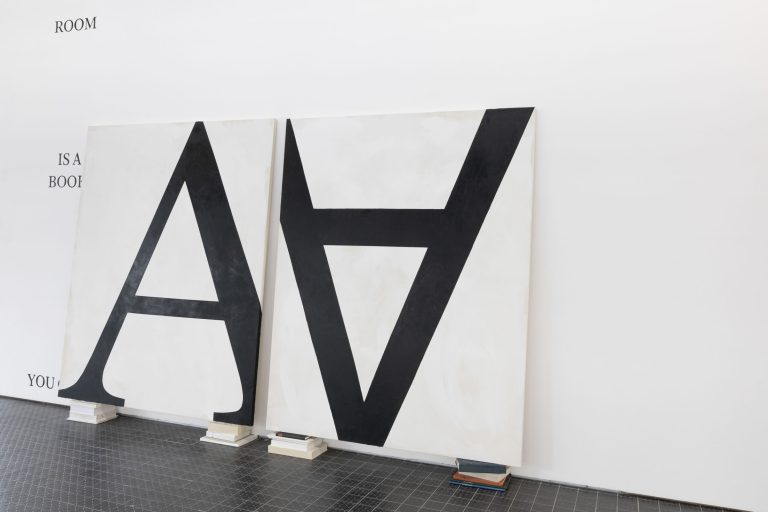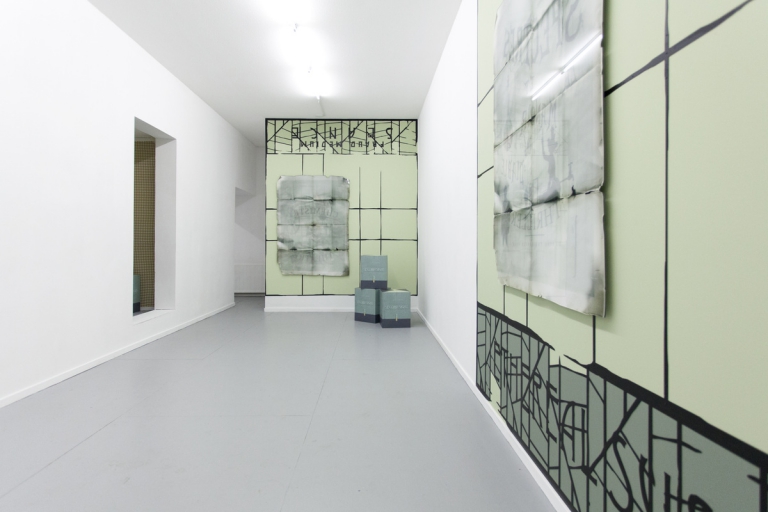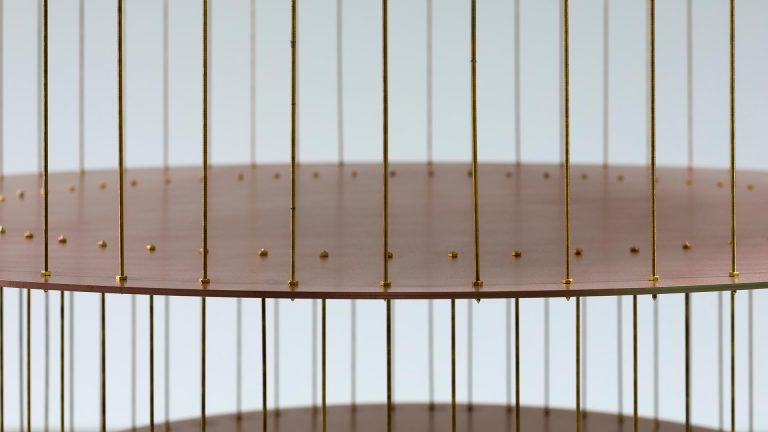Artist: Noa Eshkol
Exhibition title: I Look at the Moon and Think about My Daughter-in-Law
Curated by: Roos Gortzak
Venue: Vleeshal, Middelburg, The Netherlands
Date: January 22 – March 19, 2017
Photography: all images copyright and courtesy of the artist and Vleeshal
I Look at the Moon and Think about my Daughter-in-Law is an exhibition in two parts on the work of influential choreographer, theorist and textile artist Noa Eshkol (Israel, 1924-2007).
Disappointed with the existing notation systems for dance (Rudolf von Laban’s Labanotation for example), Noa Eshkol set out to develop a new notation system for movement. She wanted her system to provide the means for the most accurate description of “transitions” (as opposed to notating fixed poses and taking the transition from one pose to another for granted). In collaboration with architect Abraham Wachman, she succeeded in developing a unified method of writing and recording: the Eshkol-Wachman Movement Notation (EWMN) system. It uses numbers and a minimal alphabet of symbols in a grid format, offering dancers and choreographers a systematised tool to compose and notate dance – and all other forms of movement.
The conceptual merit of the EWMN is in its use of an abstract model based on the universal language of geometry and mathematics. This allows it to objectively depict all types of movement and their combinations, including those we have not yet discovered or those that cannot be described in words. This potential inherent in the EWMN paves the way to countless applications. It can be used as a tool to observe our own manners and conduct in relation to our surroundings, and can be applied to diverse areas such as the study of animal behavior, autism and sign language.
The exhibition title refers to a sentence that supposedly could not be communicated in sign language. For Noa Eshkol, this alone was a reason to test her movement notation system on the mysterious sentence. One of the group’s dancers recorded in EWMN how five deaf-mutes say: “I look at the moon and think about my daughter-in-law”. A comparison of these notations reveals that each person expressed it with different nuances of movement.
From 1954 to 1994, Eshkol developed about 50 dance compositions with the aid of the EWMN system. These dances are explicitly unadorned and sparse, rejecting musical accompaniment (the only sound allowed was a metronome), colorful costuming and decors. In nearly all of Eshkol’s compositions, a communitarian dance form, as a process of interaction among multiple bodies in space, prevails. As artist Walead Beshty beautifully wrote in a catalogue text on her work: “The movements in Noa Eshkol’s dances announce themselves as gestures by repetition and synchronization in much the same way that Roman Jakobson has noted that “pa/ is a noise and / papa/ is a word”. And yet the gestures remain unattached to a specific referent, something like what would be if “papa” never achieved its status as a word. It’s being-in-formation.”
Eshkol worked with a small group of dancers, who participated in much more than simply performing her choreographies. The Noa Eshkol Chamber Dance Group was like a community. Its members came to her house every day and were closely involved in all of her projects. They executed a large variety of tasks, from researching, archiving, and cleaning to diary keeping. The Noa Eshkol Chamber Dance currently consists of: Mor Bashan, Noga Goral, Rachel Nul-Kahana, Ruti Sela and Dror Shoval. During the opening they performed a special selection of Eshkol’s dances at Vleeshal Markt.
In 1973, Eshkol temporarily stopped making dance compositions. The only male dancer of her group was enlisted in the army, during the Yom Kippur War. Feeling incapable of composing dances without him she started making her first wall carpet – a new sort of composition. Although initially Eshkol’s minimalistic choreographies and her colorful carpets seem to be two opposite outbursts of one person’s creativity, in reality and origin these practices share a very direct link. There was a strict set of rules she also followed while making the carpets: no altering of the textile pieces that she found or was given, no usage of animal prints or textiles with human bodies, no favoring of any colors or forms. In an attempt to get away from a subjective approach to the making of her carpets, she said: “The material is dictating what I’m going to do”. Long-time friend and collaborator Mooky Dagan, now chairman of the Noa Eshkol Foundation, said that it was frustrating for her to not understand what she was doing while making her carpets, as the opposite was true for the composition of her dances, where she followed her system.
After making dance compositions for forty years, and with an overlap of twenty, Eshkol eventually traded making choreographies for these colorful abstractions. In their basis they remain part of the
same, meticulously organized, body of work: both apply very strict rules, and involve the organization of many limbs and a repetition of similar gestures, but first and foremost they share a communal goal. In making these compositions, performing her dances or experiencing them, her work offers you a filter to understand and shape the world that surrounds, and at points engulfs, us.
Eshkol continued making carpets until her death in 2007, which resulted in hundreds of carpets. The exhibition at Vleeshal Markt shows a wide range in time and style, from the very first, abstract
carpet, appropriately entitled The First Carpet (1973) to the more recent Sunset by the Lake (1995). Although made in a horizontal position, Eshkol imagined the carpets on the wall – as paintings. However, she enjoyed seeing them laid out on the floor. At Vleeshal Markt the carpets will be shown in both positions. Each week the composition of the show will change, as the audience is invited to chose another carpet to stand up and one to go down, keeping a 90 degree movement going, even in absence of the dancers, and keeping in tune with Eshkol’s nonhierarchal approach.
The second part of I Look at the Moon and Think about My Daughter-in-Law at Kunstverein in Amsterdam focuses on fields outside of dance, where the Eshkol-Wachman Movement Notation system was used. Alongside the first copy of the EWMN system, there is generous selection of scripts that notate the behaviour of different animals, and the attempts researchers made to improve the language of the deaf-mutes, among others. There are also three films that have never been screened before outside of Israel, capturing early recordings of Noa Eshkol and her dancers making use of the EWMN system as well as a chameleon on a branch. These films are screened on the window of Kunstverein’s storefront in the heart of the Jordaan, enabling both viewers inside and outside the space to be absorbed by the hypnotizing dances.
The first part at Vleeshal Markt runs from January 22 till March 19, and the second part at Kunstverein, Amsterdam is on from February 4 until March 19. I Look at the Moon and Think about my Daughter-in-Law is a collaboration between the two institutions, and has been curated by Roos Gortzak (Director, Vleeshal) and Maxine Kopsa (Director, Kunstverein).
Noa Eshkol, I Look at the Moon and Think about My Daughter-in-Law, 2017. Exhibition view: Vleeshal Markt, Middelburg. Photo: Gunnar Meier
Noa Eshkol, I Look at the Moon and Think about My Daughter-in-Law, 2017. Exhibition view: Vleeshal Markt, Middelburg. Photo: Gunnar Meier
Noa Eshkol, I Look at the Moon and Think about My Daughter-in-Law, 2017. Exhibition view: Vleeshal Markt, Middelburg. Photo: Gunnar Meier
Noa Eshkol, I Look at the Moon and Think about My Daughter-in-Law, 2017. Exhibition view: Vleeshal Markt, Middelburg. Photo: Gunnar Meier
Noa Eshkol, I Look at the Moon and Think about My Daughter-in-Law, 2017. Exhibition view: Vleeshal Markt, Middelburg. Photo: Gunnar Meier
Noa Eshkol, I Look at the Moon and Think about My Daughter-in-Law, 2017. Exhibition view: Vleeshal Markt, Middelburg. Photo: Gunnar Meier
Noa Eshkol, I Look at the Moon and Think about My Daughter-in-Law, 2017. Exhibition view: Vleeshal Markt, Middelburg. Photo: Gunnar Meier
Noa Eshkol, I Look at the Moon and Think about My Daughter-in-Law, 2017. Exhibition view: Vleeshal Markt, Middelburg. Photo: Gunnar Meier
Noa Eshkol, I Look at the Moon and Think about My Daughter-in-Law, 2017. Exhibition view: Vleeshal Markt, Middelburg. Photo: Gunnar Meier
Noa Eshkol, I Look at the Moon and Think about My Daughter-in-Law, 2017. Exhibition view: Vleeshal Markt, Middelburg. Photo: Gunnar Meier
The Noa Eshkol Chamber Dance group perform Duet (5) from the suite Theme & Variations at Vleeshal Markt (21.01.17). Dancers: Noga Goral and Dror Shoval. Photo: Gunnar Meier
The Noa Eshkol Chamber Dance group perform Peacock from the suite Theme & Variations at Vleeshal Markt (21.01.17). Dancers: Mor Bashan and Noga Goral. Photo: Gunnar Meier
The Noa Eshkol Chamber Dance group perform Peacock from the suite Theme & Variations at Vleeshal Markt (21.01.17). Dancers: Mor Bashan and Noga Goral. Photo: Gunnar Meier
The Noa Eshkol Chamber Dance group perform Small Birds in Trees from the suite Right Angled Curves at Vleeshal Markt (21.01.17). Dancers: Racheli Nul-Kahana and Ruti Sela. Photo: Gunnar Meier.
The Noa Eshkol Chamber Dance group perform Warrior (March) from the suite Right Angled Curves at Vleeshal Markt (21.01.17). Dancers: Mor Bashan, Dror Shoval and Noga Goral. Photo: Gunnar Meier.
The Noa Eshkol Chamber Dance group perform “Six” Wild Courting from the suite Diminishing Series at Vleeshal Markt (21.01.17). Dancers: Dror Shoval, Mor Bashan, Ruti Sela, Noga Goral. Photo: Gunnar Meier
The Noa Eshkol Chamber Dance group perform Gestures – II from the suite Symmetrical & Sentimental Etudes at Vleeshal Markt (21.01.17). Dancers: Racheli Nul-Kahana and Ruti Sela. Photo: Gunnar Meier
The Noa Eshkol Chamber Dance group perform Gestures – II from the suite Symmetrical & Sentimental Etudes at Vleeshal Markt (21.01.17). Dancers: Racheli Nul-Kahana and Ruti Sela. Photo: Gunnar Meier
The Noa Eshkol Chamber Dance group perform Etude from the suite Symmetrical & Sentimental Etudes at Vleeshal Markt (21.01.17). Dancers: Racheli Nul-Kahana, Ruti Sela, Dror Shoval, Noga Goral, Mor Bashan. Photo: Gunnar Meier
The Noa Eshkol Chamber Dance group perform Etude No. 2 – Formal Waltz (Hint of Classical Ballet) from the suite Symmetrical & Sentimental Etudes at Vleeshal Markt (21.01.17). Dancers: Mor Bashan, Racheli Nul-Kahana and Noga Goral. Photo: Gunnar Meier


























